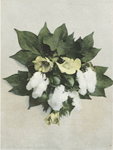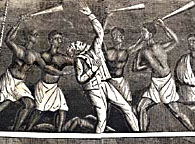The Cultural Landscape of Slavery: Farm Quarters
Historian John Michael Vlach very briefly introduces the overseer's house and slave quarters at Hampton National Historic Site.
This feature is no longer available.
Historian John Michael Vlach very briefly introduces the overseer's house and slave quarters at Hampton National Historic Site.
This feature is no longer available.
Historian John Michael Vlach compares the grounds of the main estate at Hampton National Historic Site and the slave quarters and working areas of the same estate. He points out what the differences in organization and aesthetic emphasis indicate about the division of society on the estate.
This feature is no longer available.
Historian John Michael Vlach very quickly reviews the architecture of the Hampton Estate in Towson, MD. Built in 1745, the estate's owners worked in various industries and farming ventures, and owned many slaves.
This feature is no longer available.
Dianne Swann-Wright, Director of African-American and Special Programs at the Thomas Jefferson Foundation, looks at what artifacts found at Monticello reveal about the lives of slaves on the estate and the questions such artifacts raise.
This feature is no longer available.
Dianne Swann-Wright, Director of African-American and Special Programs at the Thomas Jefferson Foundation, discusses the contributions of slaves in creating Monticello—both in clearing the land and establishing the house itself and in crafting furniture and other pieces to finish the house.
This feature is no longer available.
No details available.
What do an English historian, an Italian wine merchant, an anti-slavery advocate, and the Father of the Constitution have in common? Each of these individuals—Catherine Sawbridge Macaulay Graham, Philip Mazzei, Francis Asbury, and James Madison—paid one or more visits during the years 17831789 to the retired leader of the American Revolutionary forces, George Washington, at his Virginia waterfront plantation, Mount Vernon. Perhaps these guests marveled at the brilliant colors of the mansion's main dining room. They might have strolled around the grounds and seen the slaves performing the multitude of tasks necessary to make the plantation flourish. It's likely that the visitors sat on the east-facing piazza and watched the ships sail up and down the Potomac River. Finally, and most significantly, these visitors—and others like them—participated in dialogues and discussions at Mount Vernon which resulted in the creation of the American constitutional system. The Landmarks of American History and Culture Workshop, "Shaping the Constitution: A View from Mount Vernon 178389," funded by the National Endowment for the Humanities We the People initiative, is an opportunity for educators (and ultimately their students) to gain a better understanding of Mount Vernon as a crossroads for the discussion of ideas that led to the Constitution. In brief, the workshop offers academic content about Mount Vernon, George Washington, and the Constitution; the opportunity to engage in scholarly discourse with leading academics; a stipend to help cover housing and meal costs; a transportation allowance; networking with other social studies teachers from around the nation; and ongoing professional development opportunities and the opportunity to earn graduate credit.
This workshop will consider the myths and realities of four themes central to the figure of Abraham Lincoln. First, participants will examine Lincoln and American Nationalism. To more fully understand this theme, they will examine how historians have portrayed Lincoln over time. A starting point for this examination will be reading from primary sources including Lincoln's Message to Congress in Special Session (July 4, 1861), followed by selected sections from secondary sources: James McPherson's Abraham Lincoln and the Second American Revolution, and Barry Schwartz's Lincoln at the Millennium. Central to this examination is the question of how Lincoln used history, especially the American Revolution and the Founding Fathers, to develop his rhetorical defense of the Union and justification for action. Second, participants will consider Lincoln and power. The examination of this theme centers on the dilemma of how to fight a civil war and preserve civil liberties. Lincoln scholars will provide participants with opportunities to discuss how Lincoln attempted to preserve the Union without sacrificing the Constitution. The investigation begins with required reading of selections from David Donald's Lincoln and David Potter's Jefferson Davis and the Political Factors in Confederate Defeat. Participants will probe critical issues such as suspension of habeas corpus, censorship of the press, and declaration of martial law through reading Lincoln's Second Inaugural Address. Third, participants will consider Lincoln and freedom. It has been argued that Lincoln changed the meaning of the Constitution. Participants will investigate this theme by first reading the Gettysburg Address and selected letters in which Lincoln describes his vision of equality. Then, they will analyze selections from Garry Wills's 1992 The Words that Remade America, which suggests that the change went beyond the relationship between the federal government and the states to the relationship between the federal government and the individual. How might Lincoln's words, "a new birth of freedom" suggest change in the vision of equality? Finally, participants will consider Lincoln and race. They will examine the Emancipation Proclamation and the complex issue of race in America. Readings for this theme draw on selections from the Lincoln-Douglas debates, the Emancipation Proclamation and selected Lincoln letters, and readings from Lerone Bennet's Was Abe Lincoln a White Supremacist? and Philip Shaw Paludan's Emancipating the Republic: Lincoln and the Means and Ends of Antislavery. Much of Lincoln's position of honor in American history rests upon his action to free the slaves. Yet, some view the proclamation as an empty gesture or even a conservative attempt to forestall more radical action. These discussions will provide participants with an opportunity to explore the evolution of Lincoln's attitude toward emancipation that culminated in his support for the 13th Amendment.

What was the effect of the cotton gin on slaves?
Eli Whitney patented his cotton engine, or “gin,” in 1794. A mechanical device to separate cotton fibers from cotton seed, it dramatically lowered the cost of producing cotton fiber. Formerly, workers (usually slaves) had separated the seeds from the lint by hand, painstaking work that required hours of work to produce a pound of lint. By mechanizing the process, the gin could produce more than 50 pounds of lint per day. Cotton fabric, formerly quite expensive due to the high cost of production, became dramatically cheaper, and cotton clothing became commonplace. In the early decades of the 19th century, Southern farmers shifted more and more of their acreage into highly profitable cotton production, and large-scale plantation agriculture became common in the Deep South states of Georgia, Mississippi, Alabama, and Louisiana. The gin’s effect on the economy and on the lives of the slaves who made up a significant part of that economy was complex. The cotton gin freed slaves from the arthritic labor of separating seeds from the lint by hand. At the same time, the dramatically lowered cost of producing cotton fiber, the corresponding increase in the amount of cotton fabric demanded by textile mills, and the increasing prevalence of large-scale plantation agriculture resulted in a dramatic increase in the demand for more slaves to work those plantations. Overall, the slave population in the South grew from 700,000 before Whitney’s patent to more than three million in 1850—striking evidence of the changing Southern economy and its growing dependence on the slave system to keep the economy running. Cotton cultivation proved especially well-suited to slave labor. A relatively delicate plant, growing and harvesting cotton was a labor-intensive process. On large Southern plantations, much of that labor was provided by slaves working in gangs. Gang labor fit the slave system particularly well: dozens of slaves collected into a work crew could be supervised by a single white overseer, which made for more efficient work. Unlike solitary jobs like shepherding, which made constant supervision of individual slave workers extremely difficult from a practical standpoint, gang labor in the cotton fields allowed one overseer to supervise (and, when necessary, to discipline and punish) large numbers of slaves simultaneously.
On large cotton plantations both the work and the punishments were unremitting and unforgiving. During the height of harvesting season, slaves worked from sunup to sundown; when the moon was full, they worked into the night as well. Slaveowners varied in their reputations for physical violence, but none eschewed punishment completely in the quest to extract more labor from their charges. Beatings and whippings were frequently used to coerce recalcitrant slaves; slaves who resisted labor or attempted to escape were punished with mutilation, sale away from their families, and occasionally death. There is no simple calculus to determine whether and how the cotton gin affected the lives of individual slaves. It is possible that the adoption of the gin made the working hours of a few individual slaves somewhat less difficult. However, given the barbarity of slavery generally—rampant physical and sexual abuse, the separation of families, lives of forced labor in acute deprivation, and the overarching dehumanization that the system enforced—it seems clear that any invention that encouraged the growth and expansion of the institution increased the misery of slaves in the aggregate acutely. Given the cotton gin’s effects on the spread of large-scale cotton agriculture and the resultant growth in the institution of slavery in the first half of the 19th century, it is difficult to portray its introduction as anything other than a disaster from the perspective of enslaved African-Americans.
Economic History Association. EH.net Hounshell, David. From the American System to Mass Production, 1800-1932: The Development of Manufacturing Technology in the United States. Baltimore: Johns Hopkins University Press, 1984. Patents as Primary Sources Plantation Agriculture Museum The University Library at the University of North Carolina at Chapel Hill. Documenting the American South, 2004.
Gray, Lewis Cecil. History of Agriculture in the Southern United States to 1860, vol. 2. Gloucester, MA: Peter Smith, 1958. Reidy, Joseph P. From Slavery to Agrarian Capitalism in the Cotton Plantation South, Central Georgia, 1800–1880. Chapel Hill: University of North Carolina Press, 1992.

This is one of the richest collections of anti-slavery and Civil War materials in the world. Reverend Samuel J. May, an American abolitionist, donated his collection of anti-slavery materials to the Cornell Library in 1870. Following May's lead, other abolitionists in the U.S. and Great Britain contributed materials. The collection now consists of more than 10,000 pamphlets, leaflets, broadsides, local anti-slavery society newsletters, sermons, essays, and arguments for and against slavery. Materials date from 1704 to 1942 and cover slavery in the United States and the West Indies, the slave trade, and emancipation. More than 300,000 pages are available for full-text searching. Accompanying the documents are eight links to other collections.